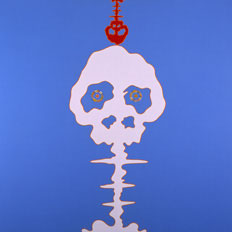In a bookstore near St. Mark’s Place in NYC I discovered the Pictoplasma book, a hardback compilation of the best in character design, taken from street art, Nintendo games, comic books and commercial graphics. After years in middle school idly doodling Yoshi and Kirby in the margins of school notes, this felt like a long overdue vindication of the work of talented cartoonists, character designers and iconographers who’d captivated mine and other kids’ imaginations.
In Japan, cute mascotry sells everything from insurance to suppositories (I made that up). The television station NHK is famous for a rotating slew of mascots, including the infamous Domo-Kun. Commercial art seems to be the sole provenance of the well designed character these days, but the best designers have always had a deeper aspect to their work: the power to condense many complex, sometimes unrelated concepts into a single image and enhance viewers’ abilities of empathy (a la comics theorist Scott McCloud‘s theory of iconography). Today I’ll take some examples from the works of Shigenori Soejima and Kazuma Kaneko, both of whom design characters for Atlus Inc.‘s flagship series of RPG titles, and show how they remake mythological material in a form which can best be described as visual storytelling.
The PS2 video game Persona 3 draws on a rich background of sources, the foremost being Carl Jung’s more mystical works involving alchemy/individuation and the Rider-Waite Tarot deck. The series is one of my favorites (profile post forthcoming) because of its coupling of social sim gameplay with pure dungeon-crawling. As a schoolboy, you make friends in the daytime, at nighttime, the strength of your friendships helps you stop encroaching shadows from overrunning a vast collective unconsciousness. The epic feel coupled with the mundane is a bit like Harry Potter, the video game, and is a fitting tribute to Jung’s vision. The high point of Shigenori Soejima’s design are the Personas, the archetypal “other selves” of the game’s main characters. Shown below is the main character and his persona, Orpheus:

Persona 3: Main Character & Orpheus
The red scarf that Orpheus wears is a reference to his disembowelment and beheading in the underworld. The school uniform seems to be a visual rhyme of the Victorian era of Jung & Freud, the protagonist looks kinda like Lil’ Nietzsche or Kierkegaard. The digital font and the robotic aspect of Orpheus finally are a mark of P3’s other main worldview: futurism. The slick surfaces of the game underscore the timelessness of the narrative which is drawn from the hero’s journey.

The direct sequel, Persona 4, also designed by Soejima, has a retro, ’70’s ethos of bright colors (one of the main characters summons a persona that dons Bruce Lee’s iconic Game of Death outfit). In this game, the collective unconscious is accessed through the television, which is a neat excuse for Soejima to throw in visual checks of Japanese television shows in his character designs from old myths: check out Konohana Sakuya via Power Rangers and Issun Boshi Sukuna Hikona, after sentai shows like Ultraman. Kuma is at once the most compelling character, and also seems to be a meta-commentary on cast-aside mascots. An oddly naive stuffed bear that the main characters encounter in their first foray into the TV world, Kuma’s design is taken straight from live action kids’ shows of adults in fuzzy suits. His insides are hollow, however, and his digs decidedly dystopian, which adds a creepy veneer to the Disneyesque. Cuteness coupled with the menace of the unconscious world is a memorable pairing, a critical dig at capitalism’s appropriation of human emotions and desires through the figure of the mascot. “Sanitization” is the word that many use in discussions of Western modernity’s worst aspects; the main significance of this word is the artificial division of the innocent, appealing aspects of life from the meanness, the guts of it.

Kuma and Kintoki-douji

Murakami's Mushroom Cloud

Ainu Flag
Kuma summons the persona Kintouki-doji (the adult version of Kintaro, that cute kid who frolics with woodland creatures). This monster could be the fodder for many hundreds of Asian Studies papers about postwar boom & anxiety, because in its cute little paws it wields a GIANT FREAKING MONSTER ATOMIC BOMB. The dominant visual theme of Persona 4 seems to be cuteness coupled with threat, alienation and dis-ease. As if to emphasize this, the dust clouds that signal enemy deaths are cribbed from globally renowned artist, Takashi Murakami (he of the Louis Vuitton bag). Later, Kuma evolves into Kamui, the name (like Kami) referring to the many spirits of Ainu mythology. The transformation makes sense, given Kuma’s outsider origins, and the design’s ethnic sources may or may not be considered nationalist– the specifics are the material of another discussion.

Vayu from Digital Devil Saga
The slightly raised leg of the Vedic god Vayu, a playable character from Digital Devil Saga, references yogic poses and the stances of traditional Hindu iconography. The devils of the game’s title are the villains AND the heroes in this game, their world is the ambiguous one common to animism and some Eastern religions: one populated by all-too-human spirits that are either apt to help or harm, often at the same time. Eschewing traditional images of devilry like ram’s horns and forked tails, Kaneko manages to efficiently convey a sense of numinosity (religious fear and also awe) first of all with the closed crocodile mouth positioned unexpectedly at the top of the head (a devourer), coupled with the saintly, ragged robes of a monk. The black and white bands around the legs remind me of checkered Balinese spirit cloths, a visual marker for ghosts and the afterlife. The character attacks with a knife held between its toes (shit is so cash), a graceful killer reminiscent of Shiva, badass slayer AND dancer. It’s an unsettling depiction of divinity, the stony face with indentations vaguely humanish yet completely impartial, a force of nature. It reflects the designers’ vision of a world where the forces of creation and destruction are inseparable, death only a step away.

In a post-Mickey world, the creatures of our design seem to increasingly lack the power to shock or excite. We’d do well to remember, as Jared Diamond exposes in Guns, Germs & Steel, that the technologies of our mind (writing), are no less singular, breathtaking leaps of genius than other landmark technological breakthroughs (fire, the wheel). A while ago, I read a passage in an archaeological article (can’t seem to find it), in which an anthropologist examines a Mesopotamian artifact, a figurine of a man with a lion’s head. Before, most art was simply figurative, she says, drawing upon natural forms. The figure marks a sophisticated advance in how humans conceptualize their relationship to nature: a technology, if you will, unprecedented in the period before the object’s creation.








